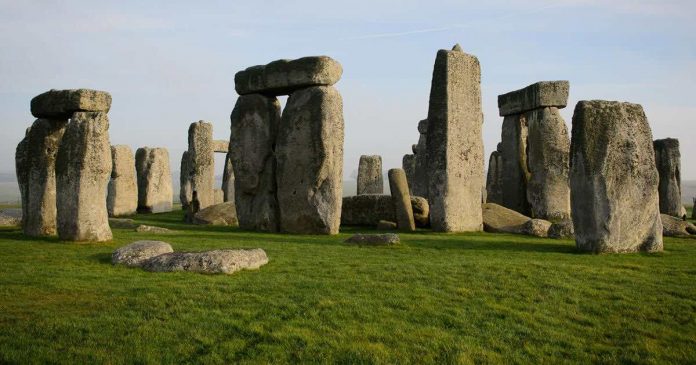Prehistoric Britons traveled impressive distances to attend celebrations at monumental sites like Stonehenge, according to new research. Incredibly, many of them brought their pigs along with them for the journey—an impressive feat, considering some participants came from hundreds of miles away.
Monumental lithic sites like Stonehenge and Avebury weren’t just constructed for show—they also served as important focal points for the community. The Neolithic Britons who built these impressive structures held ritual feasts at these complexes, which, as new research published today in Science Advances shows, drew people from across the British Isles. What’s more, these participants—who came as far as Scotland, North East England, and West Wales—brought their locally raised pigs along with them for the journey, which were then slaughtered and served at these mass gatherings.
That Neolithic Britons held feasts at Stonehenge and Avebury, as well as at less well-known sites like Durrington Walls and Mount Pleasant, is well established thanks to previous archaeological work. Pigs were the prime feasting animals at the time, as recorded by the number of pig bones uncovered at these sites.
A long-standing question for archaeologists, however, is who participated in these rituals and where they came from. Human remains from this era are exceptionally rare, mostly because Neolithic Britons practiced cremation. The idea of using pigs as a proxy for human movement has been ignored by archaeologists because these animals, unlike cattle, are hard to transport.
But as the new research shows, archaeologists shouldn’t have underestimated these ancient Britons and their desire to eat copious amounts of pork at mass gatherings.
By analyzing the isotopic signatures of 131 pigs found at four monumental sites in Southern Britain, a team led by Richard Madgwick from Cardiff University has shown that pigs were brought to these festivals from far away. The new study thus improves our understanding of where festival participants came from, while demonstrating “a scale of movement and level of social complexity not previously appreciated,” as Madgwick explained in a press release, adding that these mass gatherings “could be seen as the first united cultural events of our island, with people from all corners of Britain descending on the areas around Stonehenge to feast on food that had been specially reared and transported from their homes.”
The remains of the 131 pigs were pulled from archaeological digs at Durrington Walls, Marden, Mount Pleasant, and West Kennet Palisade Enclosures—all of which neighbor Stonehenge in South Britain. All sites date back to the Late Neolithic period, between 2,800 BCE and 2,400 BCE. To determine the geographical origin of the pigs, Madgwick’s team considered five different isotopic signatures—the largest dataset of multiple isotope methods applied to animals in archaeological research to date, according to the authors. By studying isotopes, or chemical signatures, found in the teeth and bones of pigs, the researchers can determine where the pigs were raised.
Specifically, strontium was used to determine geological provenance, sulphur for coastal proximity, oxygen to determine climatic zone, and carbon and nitrogen to determine the pigs’ diet, such as the consumption of animal protein, marine protein, plant protein, and so on. And by blending these five signals, the researchers were able to rule out certain geographical areas, allowing for a more precise determinations of origin.
Results showed, for example, that 45 pigs were raised near the coast—a rather high figure considering only one site is within 50 kilometers (30 miles) from the nearest coast. Pigs consumed at these festivals came from as far as Scotland, North East England, West Wales, and many other locations across the British Isles—and at distances involving hundreds of miles.
Pigs, unlike cattle or other bovines, are not well suited to long-distance travel, so moving them across such vast distances likely required a huge effort. It may have been important for those attending these festivals to contribute animals raised near their homes, rather than acquiring them locally, the authors speculate.
It’s entirely conceivable, of course, that the pigs were slaughtered prior to their transport, but as the authors argued in the study,
…this is very unlikely, as skulls and extremities are prevalent and these would be removed before preservation. In addition, there is no evidence for large scale, organized husbandry and preservation in Neolithic Britain. Although suitable for curing, pork spoils more rapidly than other meats, and its transport would have required a complex system of salting and/or smoking.
Christophe Snoeck, a paleoarchaeologist at the Free University of Brussels and an expert on isotope analyses, liked the new study, saying the authors did a “great job” at analyzing a large number of animals using five different isotopic systems, “making their dataset quite robust.” Snoeck, who wasn’t involved with the new research, agreed with the interpretation of data, saying the “strontium isotope results alone are pretty convincing at showing the huge diversity in origins of these animals.”
Last year, Snoeck co-authored a pioneering study in which the cremated remains of individuals buried near Stonehenge were shown to retain stable isotopic signatures. This analysis suggested the ancient remains came from people who originated in Wales, which is more than 180 kilometers (100 miles) away. The new isotopic analysis of pig remains compliments Snoeck’s work rather nicely.
“Research on Stonehenge is far from being over,” Snoeck told Gizmodo. “One avenue for further research could be to focus on trying to understand how and why people [traveled] to Stonehenge.”
But perhaps it’s no big mystery: A well-attended party involving a diverse collection of people, massive stone structures, and tons of pork is pretty damn hard to resist.








